Srishti Singh & Heeta Lakhani
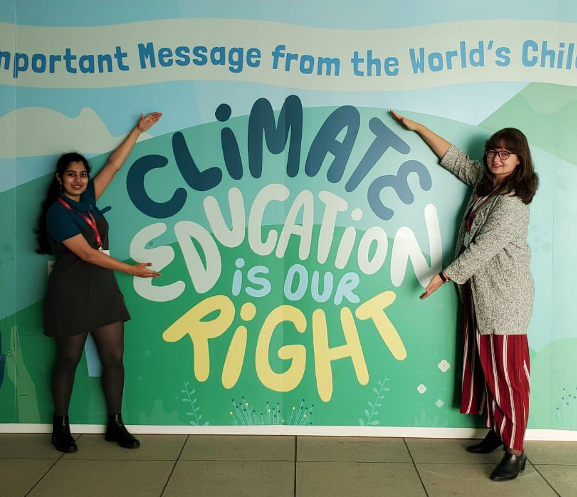
Heeta Lakhani and Marie Claire Graf, the YOUNGO Focal Points (2020-21) at COP26. Photo provided by author.
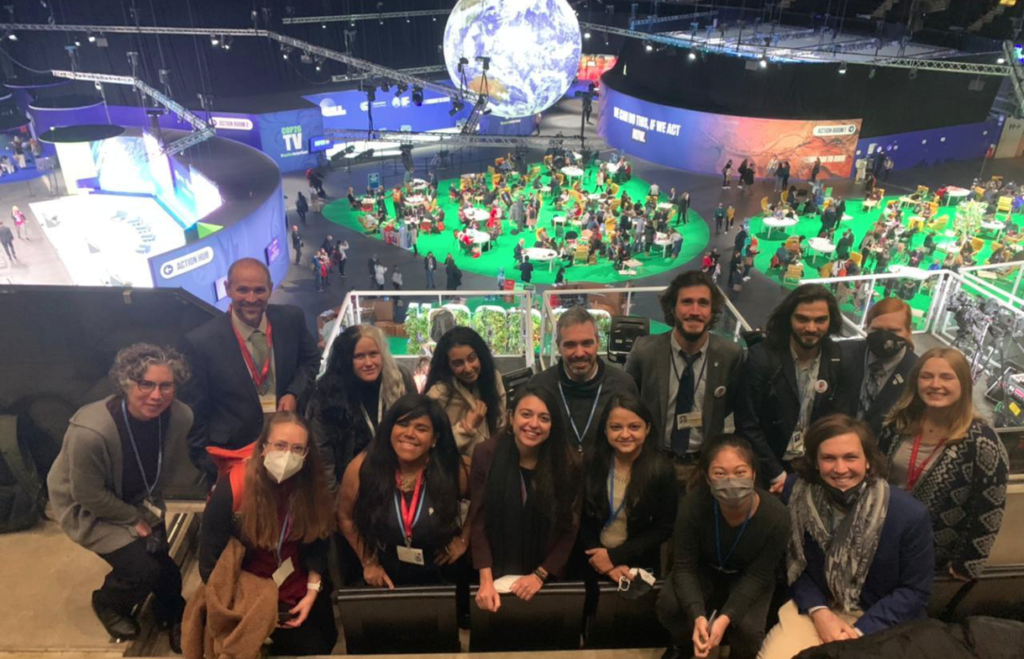
Cross-constituency ACE meeting at COP26 with participants from CAN International ECOS and YOUNGO. Photo provided by author.
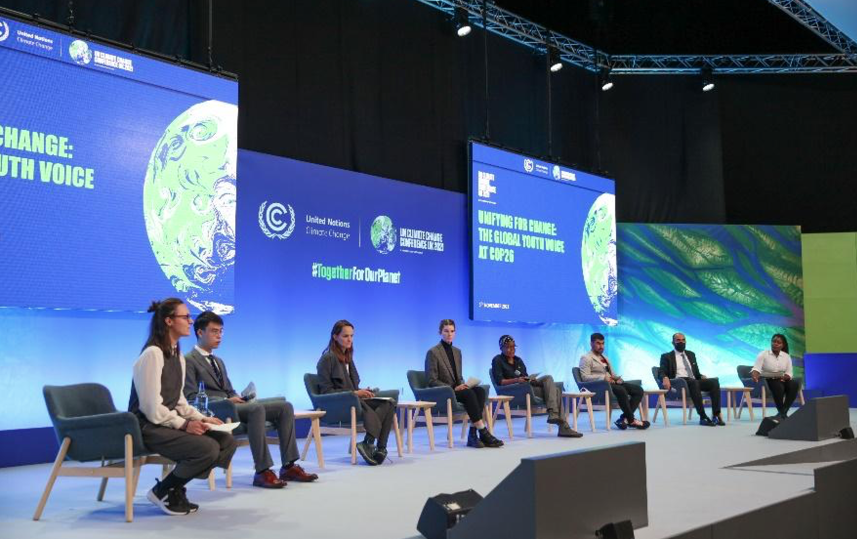
Presenters at the “Unifying for Change: The Global Youth Voice at COP26” event. Credit: Kiara Worth
Youth are the most vulnerable to the ongoing climate crisis
Youth participation in decision-making is limited
It is troubling, therefore, that youth presence at decision-making tables is so limited. Despite their vulnerability and their numbers, only one third of national governments have a Member of Parliament below the age of 30 and as few as 2.6% of National Parliaments have youth representatives (IPU, 2021). In international policy forums, youth are often allowed to participate, but they are mostly kept on the periphery and excluded from mainstream decision-making (United Nations, 2010). The UNFCCC recognizes that engaging youth in intergovernmental policy-making processes leads to more inclusive and sustainable policies (United Nations Climate Change, 2020). Through the formation of YOUNGO, the official UNFCCC constituency for children and youth, provides youth with a seat at the international climate negotiations table. Indeed, the 2021 UN Climate Change Conference, COP26, illustrated the willingness of Parties and youth to work together on climate solutions: it featured the highest-ever levels of youth participation, including 102 participation badges for YOUNGO members worldwide. However, as non-state actors, youth are merely Observers to the process. While they can make interventions during sessions or make written submissions, they have no official say in the negotiations.
What prevents youth from participating in climate change decision-making processes?
We believe there are four main reasons why youth remain on the periphery of climate change decision-making processes.
First, youth are under-represented in national level processes. Despite the Paris Agreement’s intergenerational commitment, an analysis of 160 Nationally Determined Contributions and 13 National Adaptation Plans (Benkenstein et al., 2020) found that only 7 countries position youth as stakeholders in decision-making and climate action, only 42% of national plans directly reference ‘youth’, and only 8 refer to ‘intergenerational injustice’ or ‘future generations.’ The systematic exclusion of youth in national level processes contributes to their under-representation in UNFCCC processes, especially as members of Party Delegations. It is essential that youth be included in country-level policies and policy development to strengthen their participation in national and intergovernmental decision-making.
A second reason for limited youth participation is that youth are often excluded from stakeholder consultations, which are common processes for engaging the public in decision-making. Youth might be unaware of these engagement opportunities or, according to research by the Global Centre on Adaptation (Chan et al., 2021), they might simply not be invited to join. These researchers also explain that when youth are included, they are often characterized as passive, vulnerable stakeholders who will be disproportionately impacted by climate change, rather than being framed as valued contributors to policy design.
Third, youth are often perceived to lack relevant climate change ‘technical’ expertise. This perception can mean that youth’s inputs and expertise are not taken seriously in policy forums and decision-making processes, including as part of intergovernmental processes. It is true that many young people across the globe lack a solid understanding of the causes and impacts of climate change, which limits the contributions they can make, but we believe these limitations are primarily due to the lack of access to quality climate change education.
The fourth reason is financial. Youth are prevented from participating because there is a lack of funding to support their attendance and to support youth-led initiatives that can empower them to engage effectively.
How can youth participation in climate change decision-making be strengthened?
Climate change education is undoubtedly the most powerful tool available to prepare youth to address climate change, including to participate in decision-making. Indeed, young people’s education has been recognized as key to society’s response to climate change and to strengthening the resilience and adaptive capacity of communities worldwide, most recently, in the Glasgow Work Programme on Action for Climate Empowerment (UNFCCC, 2021).
Mainstreaming action-oriented climate change education is key to addressing the climate crisis as it can cultivate young adults who are well-informed and willing to engage. Effective climate change education in formal school settings will require a curriculum that extends beyond scientific concepts, to integrate social, political, economic, and technological dimensions of climate change, traditional knowledge, systems thinking, as well as experiential and action-based learning.
Alongside climate change education in schools, increasing youth participation in climate change related policy decision-making will also require investment in each of the six ACE elements (United Nations, 2022). This would include capacity building initiatives such as youth technical training, and promotion of green jobs and sustainable entrepreneurship. It would require investment in informal communication and non-formal learning mechanisms that include experiential and on-site learning, and action research. It would also involve establishing networks and partnerships to exchange knowledge and best practices. This investment is essential to empower youth to transition from the most vulnerable group of society to leaders of change who can tackle the global climate emergency.
Youth should not be solely responsible for seeking out opportunities to build relevant skills and knowledge. Rather, this should be a two-way process. Governments must ensure that climate policies emphasize youth participation and create capacity development opportunities. It is therefore necessary for policy makers to adopt inclusive approaches to decision-making, recognize youth as change agents, and invite them to participate in country-level climate policy discussions. It is also necessary that national climate plans include climate change education. We believe that quality, action-oriented climate change education and communication provides a foundation through which youth will develop the capability to respond to climate change, and participate effectively in decision-making processes.
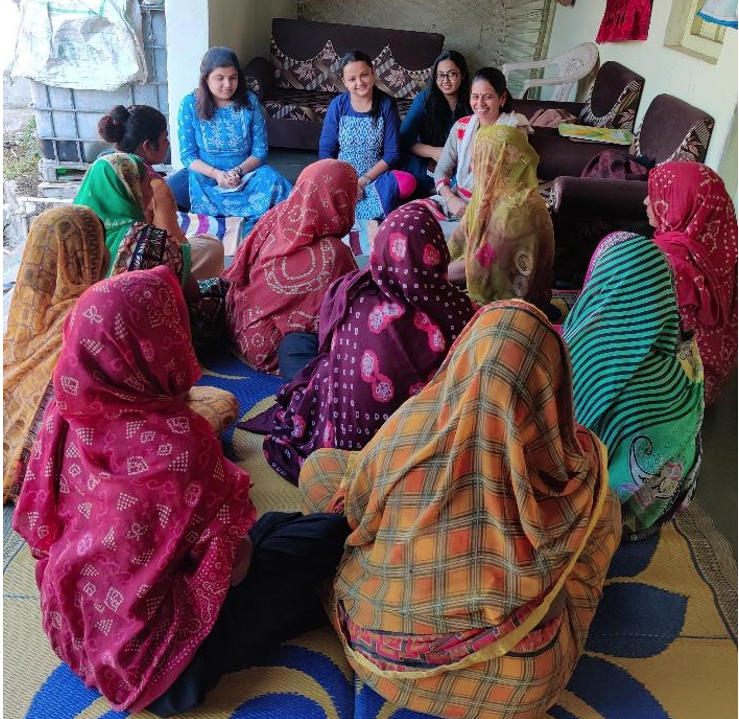
Srishti Singh leads a focus group discussion in rural areas of Gujarat to understand climate-related vulnerabilities of agriculture dependent communities and challenges to education for young girls. Credit: Nitin.
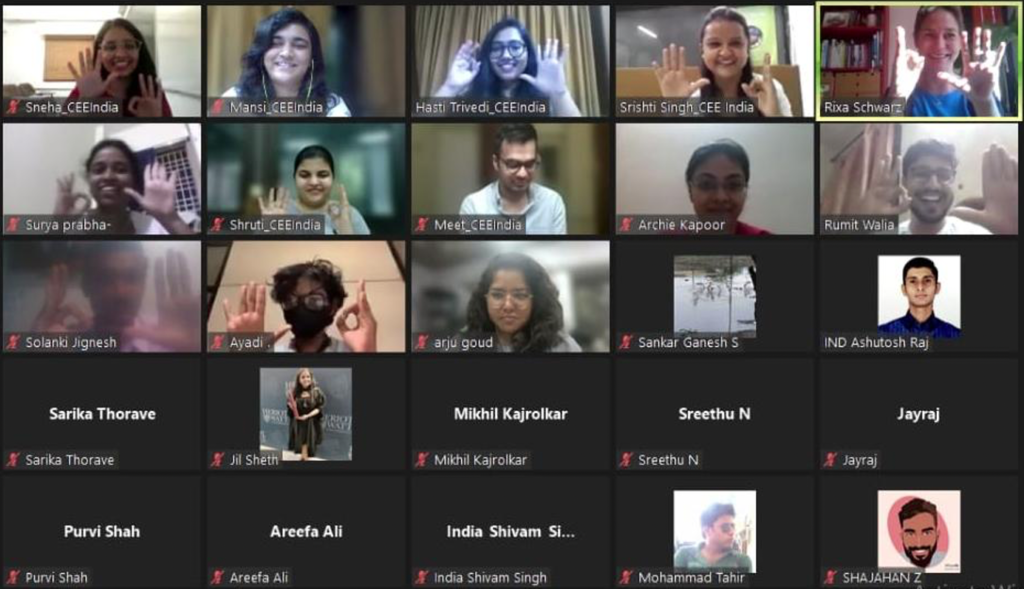
The 2021 Local Conference of Youth India, a YOUNGO Initiative implemented by the Centre for Environment Education. Photo provided by author.
How can I learn more?
The MECCE Project’s webinar, “Youth Participation in Policy Decision-making on Climate Change Communication and Education” showcased examples of youth participation in policy and decision-making processes related to climate change education at intergovernmental and local levels.
For more information on the global MECCE Project’s work on climate change communication and education, visit www.mecce.ca.
About the Authors

Srishti Singh leads the Climate Change Programmes at the Centre for Environment Education, co-chairs the MECCE Australasia Regional Hub Network and, since 2019, has been involved in the UNFCCC negotiations with a focus on Action for Climate Empowerment (ACE). Srishti has a Master’s degree in Environment Management from Forest Research Institute, India, and extensive experience in locally-led adaptation, resilience building and climate education, including leading a UNFCCC award winning initiative – Global Resilience Partnership Programme – to build the climate-resilience capacities of urban poor in South Asia. Srishti believes in the power of participatory approaches to policy making and implementation.

Heeta Lakhani is a climate educator, with a Master’s of Science in Environmental Studies and Resource Management from TERI University, India. She is a firm believer in the power of youth participation in grassroots and international processes. She was introduced to the world of the UNFCCC at COP21 in 2015 and since then, has been active locally and internationally, working towards creating change-makers who combat the climate crisis with knowledge-based action. She founded The ClimAct Initiative in India that focuses on bridging the gap between climate education and action. At COP25 in Madrid, Heeta was elected the Global Focal Point for YOUNGO for 2020-21. She is now working on training young people to be effective negotiators in the UNFCCC intergovernmental processes through the Climate Youth Negotiator Programme.
References
- Benkenstein, A., Chevallier, R., Kosciulek, D., Lebea, D., & Worth, K. (2020). Youth climate action and the role of government. In Youth Climate Advocacy (pp. 42–63). South African Institute of International Affairs. http://www.jstor.org/stable/resrep29503.9
- Chan, S., Singh, S., Chang, K., Tailor, P., Joshi, M., Mohan, M., & Amponsem, J. (2021). Young People and Drivers and Barriers to Climate Adaptation Action. https://gca.org/reports/young-people-and-drivers-and-barriers-to-climate-adaptation-action
- Hausfather, Z. (2019). Analysis: Why children must emit eight times less CO2 than their grandparents. Carbon Brief: Clear on Carbon. https://www.carbonbrief.org/analysis-why-children-must-emit-eight-times-less-co2-than-their-grandparents
- (2021). Youth Participation in National Parliaments. https://www.ipu.org/youth2021
- (2021). Glasgow work programme on Action for Climate Empowerment (Advance unedited version) (Decision-/CMA.3). https://unfccc.int/documents/310896
- United Nations. (n.d.). Youth and the SDGs. Sustainable Development Goals. Retrieved February 18, 2022, from https://www.un.org/sustainabledevelopment/youth/
- United Nations. (2010). World Report Youth: Youth & Climate Change. United Nations. www.un.org/youth
- United Nations. (2019). Total population, both sexes combined, by five-year age group (thousands). Work Population Prospects. https://population.un.org/wpp/Download/Standard/Population/
- United Nations. (2022). What is Action for Climate Empowerment? United Nations Climate Change. https://unfccc.int/topics/education-youth/the-big-picture/what-is-action-for-climate-empowerment
- United Nations Climate Change. (2020). Young People Are Boosting Global Climate Action. Https://Unfccc.Int/, August, 1–6. https://unfccc.int/news/young-people-are-boosting-global-climate-action
